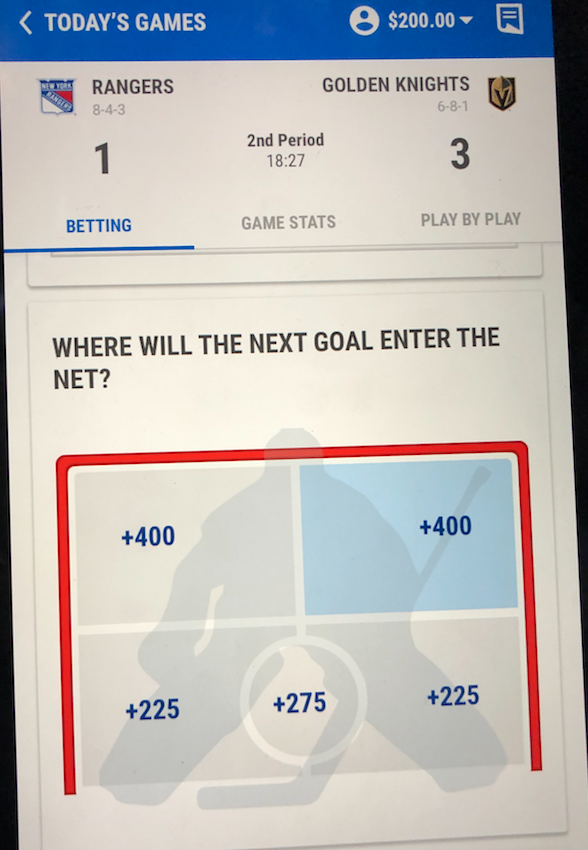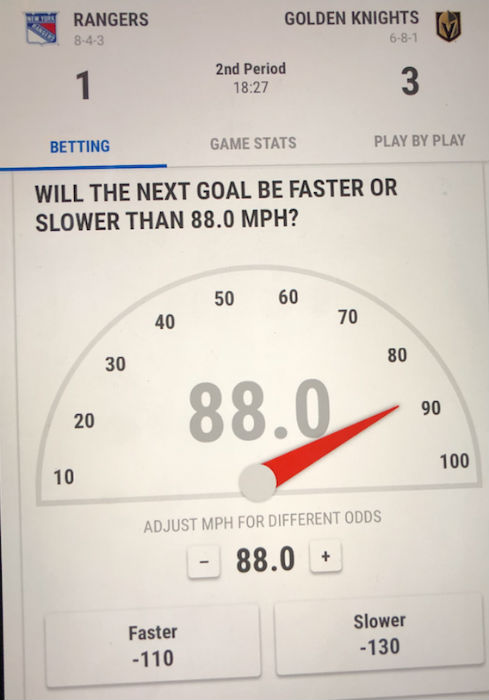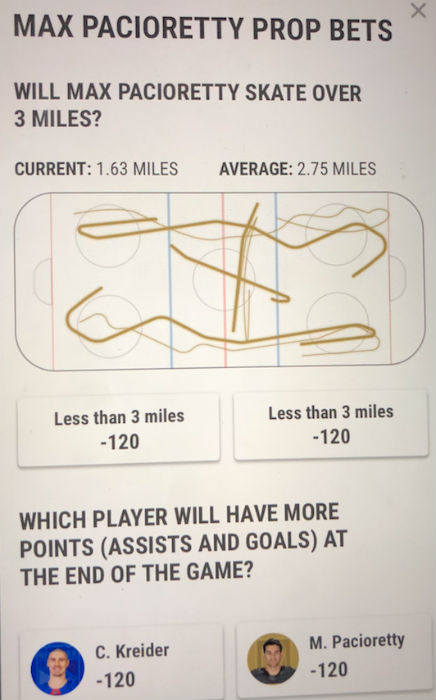San Jose vs. Vegas is reason enough to be at T-Mobile Arena on Thursday night. The two teams have combined to win 11 games in a row, chasing the similarly scorching Calgary Flames in the Pacific Division.
But something else is going on. As the game begins, a few of us are looking at an iPad. On-screen is a prototype created for the NHL by BetGenius, which supplies casinos, sportsbooks, and leagues with live data for gambling purposes.
Just 1:34 in, Sharks goalie Martin Jones kicks a Ryan Reaves shot right to Tomas Nosek. Suddenly, it’s 1-0 Golden Knights and the arena is a madhouse.
The odds on the iPad disappear for a moment. When they return, they have changed to reflect the score. Didn’t like what you saw 94 seconds ago? Check again, because it is a whole new world.
Chris Dougan, Genius Sports’ Group communications director, smiles at my reaction.
“The data is the oil,” he says. “The algorithm is the engine.”
[snippet id=3816507]
I am Brett Howden.
Wearing a virtual reality headset, I am suddenly in the Ranger forward’s skates for one of his shifts from Tuesday’s loss in Vegas.
“Look down,” says Sander Schouten, chief operating officer & co-founder of a Dutch company called Beyondsports, owner of this equipment. When I do, I “see” the puck at my feet. As play continues, Howden is at the Golden Knights’ blue line with a decision to make. The puck is coming towards him.
Schouten tells me to look around, and suddenly I see everything Howden can see to make his choice. His virtual reality project can be exactly what I experienced, an opportunity for fans to pick a player and see the game through their eyes. (If you prefer, you can watch Lego People instead of “real” people.) It could be used a coaching tool. It could also be used as part of a broadcast.
Schouten’s biggest current client is FOX Sports. He plays a VR highlight from a Premier League game between Chelsea and West Ham. One of the players takes a bad shot, not realizing a teammate was open for a better chance. By changing the angle of the video, analysts can point out how the shooter should have been able to see his teammate.
So, does the NHL’s data have value for you, I ask?
“Absolutely,” Schouten answers.

The Golden Knights hosted two games this week: Tuesday against the Rangers and Thursday versus the Sharks. With the approval of the NHLPA, players on all three teams wore tracking chips on their jerseys and a specially made puck (with a chip inside) was used. Other NHL clubs were invited to attend, see how the data could be collected and disseminated and ask questions.
While this was going on, the massive CES convention was also taking place in Las Vegas.
Run by the Consumer Technology Association, CES attracts almost 190,000 people, more than 4,400 exhibitors and 1,000 speakers. CES is a can’t-miss event if you want to see where the world is heading. The NHL used the opportunity to invite approximately 100 people to a suite for both games. Several stations were set up to sample the technology.
The important thing to understand is that if you are someone who just wants to sit down and watch a game — no frills, no odds, no virtual reality — you’re going to be able to do that. The NHL and NHLPA do not want to alienate anyone who prefers it that way. But, if you want a different experience — and everyone knows the younger generations crave one — good news is coming.
Honestly, there are so many more possibilities than I realized. As a result, there is much to learn.
“The number of things you can do is a surprise,” said NHL deputy commissioner Bill Daly. “And we’re excited to see where it can go.”
Expect some news during all-star weekend
The NHL will announce its Player- and Puck-Tracking plans during All-Star Weekend Jan. 26-27 in San Jose. Commissioner Gary Bettman was determined to make it work. Word is the league made a significant financial investment into the research and development.
“We spent well into seven figures on this,” he said Thursday night. “That shows the commitment of the owners, their faith in our vision.”
“(The Commissioner) also told us, the information has to be available in ‘real-time’ or don’t bother,” said David Lehanski, the NHL’s senior vice-president of business development & global partnerships.
Is he satisfied?
“Yes,” Bettman answers, before continuing. “Originally, we saw this as a broadcast application. Nobody knew when we started that we would see legalized gambling.”
At some point, though, the league could see which way the winds were blowing.
The NFL shared some Nielsen research data with the NHL. It indicated that people who wagered watched 19 more football games per season than those who didn’t. And, 75-80 per cent of the bets are in-game, as opposed to putting down cash on the spreads beforehand.
Some examples of the in-game prop bets that are part of the BetGenius prototype:
Where will the next goal enter the net?

Will the next goal be faster or slower than 88 m.p.h.? (The key here is the bettor can change the number as they wish)

What area of the ice will the next goal be scored from?

When the NHL went to Vegas, the league indicated one of the reasons it wasn’t worried about gambling was because not much was bet on hockey games.
Will these kinds of in-game offers make a difference? The NFL numbers indicate yes.
“We saw it in the Premier League,” Dougan adds. “This creates interest. This creates engagement.”
Betting is going to drive the bus
Before the Vegas game begins, I’m standing next to a computer monitor showing Toronto vs. New Jersey. It’s 3-2 Maple Leafs after two periods. On the right side of the monitor is the option to click on highlights from the first 40 minutes.
“There are 263 plays ready to go,” says Shachar Arnon, head of business development in North America for WSC Sports.
(Arnon won’t let me take a photo of the screen. He’s not the only one. No one wants their secrets revealed.)
“What we advertise are highlights as if a human cut them,” he says.
The plays do make sense.
“And we don’t clip broadcasters’ words, either.”
A second option is to pick highlights from a bigger library. I tell him to give me a pack featuring Mitch Marner and John Tavares (yes, I know this is a nauseating selection for non-Leaf fans). You can select how long you want it to be. He goes with three minutes. You can also choose game situations.
WSC’s clients include the NBA, its individual teams and Turner Sports. Right now, many of you get text alerts on your smartphones or tablets when something you care about happens. He wants his program to send you video alerts, too.
He talks about a night Steph Curry had a huge game in the NBA. But Utah’s Rudy Gobert, who is French, had six blocks. They made sure to send a highlight of Gobert’s blocks to French customers. That was watched more by those consumers than Curry’s performance.
In an international league like the NHL, that resonates. You can target advertisements with that knowledge.
“Does the NHL’s data have much value for you?” I ask.
“That’s why we are here,” Arnon answers. “This information is beginning to have real value and real return of investment.”
Is it possible to quantify that value?
“That’s really to be determined,” Bettman says.
He’s not being evasive. People who know a lot more about this than I do indicate they’re not sure where this is going, yet. There’s a lot of energy and enthusiasm. It’s clear, however, that betting is going to drive this bus.
Where does the NHLPA stand on all this?
If there is anyone who might have thrown cold water on this experiment, it was the players. We’ve talking so much about gambling, virtual reality, highlights and data that we’ve almost totally forgotten about the tracking.
The risk for the players is that this will make it known who is slowing down, who has been affected by injury and that it will be used against during contract negotiations. And, as part of the NHL/NHLPA agreement on this, nothing from tracking data can be used in salary arbitration hearings.
“We have to do it,” says NHLPA special assistant Mathieu Schneider. “If you are standing still, you are falling behind. It is happening in every sport. You can’t avoid it.”
“We will all be using the same numbers. At least if you are being judged, we will all be doing it from the same data. More accurate information.”
According to the NHL, approximately 18 teams made the trip to Vegas. Those who would talk say this is going to be very helpful to their teams, once they figure out how to mine an incredible amount of data.
“It will be massive,” one representative said. “No one’s going to know how to use it properly at the beginning.”
Another said it will open jobs for people who are good at coding. “(Each organization) is going to need depth. People with elite coding abilities.”
What is uncertain is when the project will officially begin. Maybe not for the start of the 2019-20 season, but some point during it. Take your time. There cannot be false starts. It must be done right.
Everyone is entering unchartered waters
When tracking was used at the 2015 Columbus All-Star Weekend and at the 2016 World Cup of Hockey, the puck looked different than it does now. The previous ones had holes in the sides because they used infrared technology.
“It was a good system,” Lehanski said. “But no one liked the look.”
Bettman also warned manufacturers that he didn’t want to see pucks splitting in two during games.
Enter Jogmo, a German-based company creating hardware and software that generates real-time tracking data for team sports.
“We’d done tracking technology in soccer, but saw better opportunities for growth in North America,” said Martin Bachmayer, Jogmo’s founder and CEO. “We reached out to the NHL three years ago. We wanted the challenge. If we could do hockey, we could do anything.”
The challenge? Create a “new” puck that could withstand the impact, the cold, the glistening ice surface — all obstacles to accurate real-time data. Bachmayer opened one puck but would not allow a photograph of it. At the All-Star announcement, there is expected to be a video illustrating how one is made.
“We had to create a new rubber recipe,” Bachmayer said. “The other one had too much carbon. We could not get a signal (from the chip).”
There was also a previous concern about cost. The World Cup’s pucks cost between $150-$200. That’s no longer the case, with sources indicating we’re down to around $50 and hopes that will drop even lower.
Schneider said some players noticed a difference, while others couldn’t.
“By the time everything is rolled out, we’re confident everything will be settled,” he says.
Prior to trying it with NHL players, the UNLV hockey team wore chips as test subjects. They were also placed on the men and women who clean the ice during commercial breaks.
“We put one on one of the shovels and on a Zamboni as it drove out of the bowl, just to see how far the signal worked,” Lehanski said.
Teams will carry their players’ sensors with them, receiving about 50 per team, so each player will have their own designated chip. Each dressing room will have a charging station.
Each arena will be fitted with 12-14 antennae in the rafters and four-to-six more in the lower bowl or at ice-level (to capture elevation). Somewhere down the road, Lehanski adds, there is the hope of adding optical tracking, too.
The data will go from Jogmo’s chips to servers run by SMT, a highly regarded company that developed the NFL’s yellow first-down line. (It also bought Sportvision, which created the NHL’s old glowing puck.)
SMT displayed a monitor for commentators that showed how many feet a player skated, how much he played, how long his last shift was and how much zone time each team had.
That was how I learned Burns played the final 4:12 of Thursday’s game. He skated 22,437 feet, approximately one mile more than anyone else on either team (I’m tired just writing that). The Sharks had the puck in the Vegas end 43 per cent of the time. Meanwhile, the Golden Knights were in San Jose’s zone just 26 per cent of the time. Again, all of this came from the raw data.
SMT will then send the info to the NHL and NHLPA, who will decide who — broadcasters, sportsbooks, casinos, whoever — gets what. That’s where the business comes in.
As everyone hopes to grow revenues, this is fascinating and unchartered waters.











